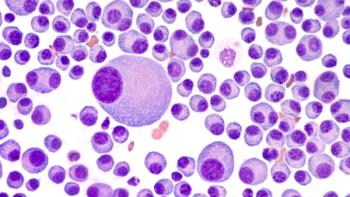
Protein Linked to Aggressive Triple-Negative Breast Cancer
The Cx26 protein may be involved with promoting aggressive breast cancer.
Researchers may have found an important protein to target in the fight against aggressive triple-negative breast cancer, according to a study published in Nature Communications.
Hormones such as estrogen and progesterone are known to drive the growth of cancer cells in patients with breast cancer. In many cases, triple-negative breast cancer can develop resistance to hormone therapy, as its cells lack the receptors that bind to a hormone.
Researchers hypothesize that cancer stem cells are a major reason why triple-negative breast cancer is difficult to treat. Cancer stem cells are able to grow rapidly and can alter their phenotype to fit the tumor environment, according to the authors.
“Triple-negative breast cancer is resistant to treatment and has a high recurrence rate,” said study author Ofer Reizes, PhD. “This aggressive subtype accounts for about 15-20% of breast cancers. Our findings are at an early stage, but we are hopeful that targeting these cancer stem cells will lead to new treatments to allow women to be treated successfully and improve their outcomes.”
The researchers examined a pathway in triple-negative breast cancer cells to determine a potential target for future treatment.
They discovered that a specific protein that was originally believed to prevent tumor growth may actually promote tumor growth. The connexin 26 (Cx26) protein allows a tumor to progress by facilitating communication between cells, according to the study.
The study showed a high presence of Cx26 in triple-negative breast cancer tissue compared with healthy breast tissue. The protein was also observed to be more abundant in cancerous stem cells than healthy stem cells, according to the study.
Interestingly, Cx26 was found on the surface of healthy cells but was located inside of cancerous cells.
The authors also discovered a link between Cx26 and 2 other tumor-promoting proteins, further suggesting an association with aggressive disease.
These findings may lead to new breast cancer treatments that target the Cx26 protein in an effort to curb drug-resistance, according to the authors.
“Additional research is needed, but this discovery suggests that inhibiting Cx26 and the related pathway may be a promising new strategy for stopping or preventing triple-negative breast cancer stem cells from self-renewing and spreading,” said co-author Justin Lathia, PhD. “It may also offer a target for diagnostic testing that helps clinicians predict health outcomes and relapse-free survival for patients with a specific cancer type.”
Newsletter
Stay informed on drug updates, treatment guidelines, and pharmacy practice trends—subscribe to Pharmacy Times for weekly clinical insights.




















































































































































































































